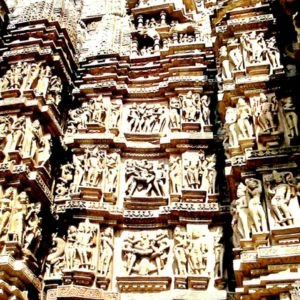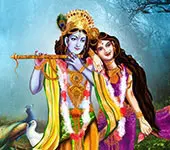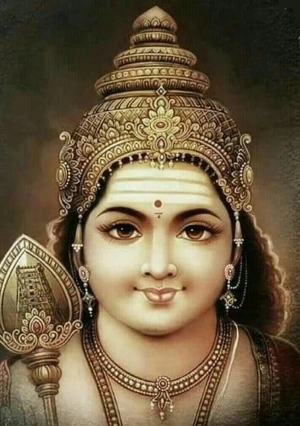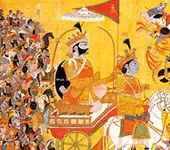This audio tells you about- 1. How Mahabharata got its name. 2. How Vyasa composed Mahabharata. 3. Meaning of the term Itihasa. 4. Purpose of Itihasas and Puranas.
Comments
Read more comments
Itihas in English meaning
इतिहासः – इतिह आस्ते अस्मिन्. Itiha means traditional knowledge and advice for a virtuous living. That which contains itiha is Itihasa. Mahabharata and Ramayana, both contain itiha or paramparya upadesha about dharma.
Where Mahabharata war happened
Mahabharata war happened on the battlefield of Kurukshetra which is in the present-day Haryana state of India.
How many days did Mahabharata war last?
Mahabharata war lasted for eighteen days.
Quiz
In which Chhandas (meter) is Mahabharata written ?Transcript
(Click here to read more)
Mahabharata is called Itihasa. The other Itihasa is Ramayana. इतिहासपुराणाभ्यां वेदं समुपबृंहयेत् The principles of Vedas are very difficult to understand. They should be expounded and understood with the help of Itihasas and Puranas. निर्णयः सर्वशास्त्राणां भारतं परिकीर्तितम् The final answer to shastras is Bharata. Shastra mentioned in Bharata ....
Transcript
(Click here)
Mahabharata is called Itihasa.
The other Itihasa is Ramayana.
इतिहासपुराणाभ्यां वेदं समुपबृंहयेत्
The principles of Vedas are very difficult to understand.
They should be expounded and understood with the help of Itihasas and Puranas.
निर्णयः सर्वशास्त्राणां भारतं परिकीर्तितम्
The final answer to shastras is Bharata.
Shastra mentioned in Bharata is final.
Principles of dharma mentioned in Bharata are final.
And the author of Bharata is none other than Sri Hari himself.
यथा स भगवान् व्यासः साक्षान्नारायणः प्रभुः
Vishnu Purana says –
कृष्णद्वैपायनं व्यासं विद्धि नारायणं प्रभुम्
कोह्यन्यो भुवि मैत्रेय महाभारतकृद्भवेत्
Know Vyasa to be Narayana himself.
Who else can create something as astounding as Mahabharata?
Once, Vyasa Maharshi told Devas to weigh shastras.
They put Mahabharata on one side of the balance and all the other shastras, scriptures on the other side.
Mahabharata stood heavier.
भारतं सर्ववेदाश्च तुलामारोपिताः पुरा ।
देवैर्ब्रह्मादिभिः सर्वैरृषिभिश्च समन्वितैः ।
व्यासस्यैवाऽज्ञया तत्र त्वत्यरिच्यत भारतम्
It is because Mahabharata stood heavier than all other scriptures, because of its weight it is called Bharata.
And because of its greatness Mahabharata.
महत्वाद्भारवत्वाच्च महाभारतमुच्यते
The importance of Bharata is that the principles of dharma and adharma, righteousness and unrighteousness are not only declared as in Smritis and Dharma-sutras, they are also established with real-life examples in Mahabharata.
निर्णयः सर्वशास्त्राणां सदृष्टान्तो हि भारते
मतिं मन्थानमाविध्य येनासौ श्रुतिसागरात्
प्रकाशं जनितो लोके महाभारतचन्द्रमाः
While the Devas and Asuras were churning the milky ocean, the moon came out of it.
Likewise, when the Shrutisagara the ocean of Vedas, the ocean of knowledge was churned by Vyasa what came out was Mahabharata like a moon spreading its light all over the world.
यो विद्याच्चतुरो वेदान् सांगोपनिषदान् द्विजः
न चाख्यानमिदं विद्यान्नैव सस्याद्विचक्षणः
The scholar who knows all the four Vedas along with their six angas such as Shiksha, Niruktam, and Upanishads he can not be called an acclaimed scholar if he doesn’t know Mahabharata.
यदिहास्ति तदन्यत्र
यन्नेहास्ति न तत्क्वचित्
Whatever is there in Mahabharata that alone you can find them elsewhere also, but if there is something that is not there in Mahabharata, you will never be able to find it elsewhere.
And how did sage Vyasa get to know about all this?
Bharata is huge, the incidents narrated here, the principles elaborated here are enormous in terms of size itself.
What were Vyasa's resources?
We know Vyasa is Maha Vishnu himself.
भारतस्येतिहासस्य धर्मॆणान्वीक्ष्य तां गतिम्
प्रविश्य योगं ज्ञानेन सोऽपश्यत् सर्वमन्ततः
Sitting in a cave at the base of the Himalayas in yoga bhava, he saw all these inside him.
He didn’t read it from somewhere, or hear it from someone.
Like a movie, he saw everything within himself, playing out scene by scene, with the power of yoga.
Everything is explained here, whatever incidents have happened in the past, what we today call History, thery are all explained in Bharata.
There are two kinds of explanations- concise and elaborate.
Whatever should be explained concisely, only essentials, they are explained that way.
And wherever details are required, they are explained that way.
तपसा ब्रह्मचर्येण व्यस्य वेदं सनातनम्
इतिहासमिमं चक्रे पुण्यं सत्यवतीसुतः
Mahabharata is an expansion of Vedas and Sage Vyasa accomplished this task through his tapas and brahmacharya.
Brahmacharya is not always celibacy.
It has other meanings also, brahma is mantra, brahmacharya also means the path of mantras, depending on the power of mantras.
What is the meaning of the term Itihasa?
इतिहासः – इतिह आस्ते अस्मिन्
Itiha means Paaramparyopadesha, advices are there in this; how to live a fruitful, worthwhile, complete, righteous life.
Learning what is right and wrong through examples.
Looking at how others lived, clarity comes, how to live, hence it is called Itihasa.
Both Bharata and Ramayana, it is from these that you learn how to live.
धर्मर्थकाममोक्षाणां उपदेशसमन्वितम्
पूर्ववृत्तकथायुक्तं प्रचक्षते
Advice with respect to all four Purusharthas- Dharma, Artha, Kama, and Moksha.
And incidents of the past, it is not fiction.
They are all real incidents.
Katha does not necessarily mean story, imagination as in English.
In Sanskrit, Katha also means vartha, vakyam.
The word Katha conveys a wrong impression.
That it is a myth or somebody’s imagination.
In Sanskrit, it is not so.
Here, they denote news from the past, incidents from the past, that is why Itihasa is often equated with History.
Recommended for you
A Glimpse into the 64 Arts

The 64 Arts, an ancient compilation of diverse skills and talents encompassing singing, dancing, painting, culinary arts, and much more.....
Click here to know more..Knowledge Sometimes Harms Spiritual Progress

This audio discourse which is part of Bhagavata series tells you how knowledge sometimes impedes your spiritual progress....
Click here to know more..Subramanya Dhyana Stotram

shad'aananam kunkumaraktavarnam mahaamatim divyamayooravaahanam. rudrasyasoonum surasainyanaatham guham sadaa'ham sharanam prapadye.....
Click here to know more..
English Topics
Mahabharatam
Click on any topic to open
- 96 Two Curses That Worked against Karna
- 95 What is behind Calling the Five Brothers the Pandavas
- 94 Give up an Individual IF....
- 93 Fascinating Birth Story of the Kauravas
- 92 Overcoming Grief - Lessons from King Senajit's story
- 91 Yayati's Wisdom
- 90 Yayati's Story
- 89 Brahmacharis Can Bless And Curse
- 88 Human Nature - Comples Mix Of Good And Bad
- 87 Results Of Good Karma
Please wait while the audio list loads..
31
Ganapathy
Shiva
Hanuman
Devi
Vishnu Sahasranama
Mahabharatam
Practical Wisdom
Yoga Vasishta
Vedas
Rituals
Rare Topics
Devi Mahatmyam
Glory of Venkatesha
Shani Mahatmya
Story of Sri Yantra
Rudram Explained
Atharva Sheersha
Sri Suktam
Kathopanishad
Ramayana
Mystique
Mantra Shastra
Bharat Matha
Bhagavatam
Astrology
Temples
Spiritual books
Purana Stories
Festivals
Sages and Saints
Bhagavad Gita
